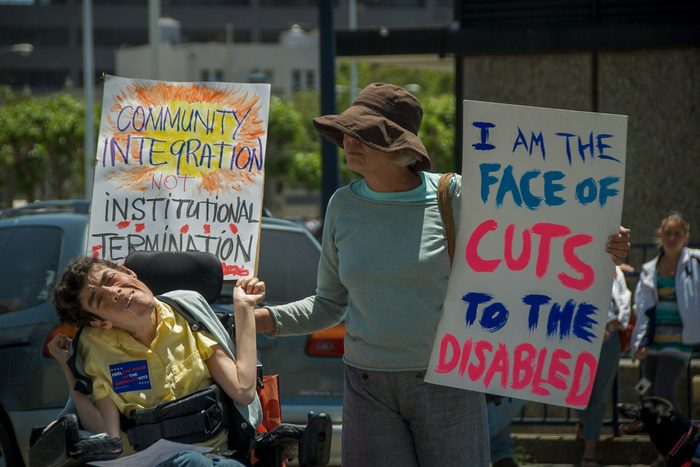With Covid Delays, You May Die Waiting for Disability Benefits
Disabled people already had to cut through a lot of red tape to get benefits. Coronavirus made it even harder.
Bobbi Dempsey

Jade Dunham was 15 when she was diagnosed with rheumatoid arthritis.
Since then, she says, she has been on “almost every medication on the market for my condition.”
The disease is chronic and debilitating, and Dunham’s symptoms are wide-ranging. They affect nearly every routine task she attempts.
“My shoulders no longer have cartilage, and I have holes in the humeral head of both joints [at the shoulder], meaning I will require both to be replaced,” Dunham says. “I can no longer lift my arms above the elbows without severe pain. My left foot and ankle are bone-on-bone and become so painful to walk on, I have to crawl.”
“My hands are damaged, my knees are damaged, my neck cracks and pops to the point I get severe headaches,” Dunham adds.
Because of the severity of her rheumatoid arthritis, Dunham, now 28, is unable to work. Last fall, she and her husband were living in an old RV in southeast Minnesota, the only option they could find. But the RV had no heat, leaving them in a tough situation as the colder weather rolled in. Dunham’s husband has additional health issues, making his employment sporadic and unpredictable.
In July 2019, Dunham applied for Social Security Disability Insurance (SSDI), a federal program meant to provide basic financial support to people unable to work because of a disability. The program is managed by the Social Security Administration (SSA).
The average monthly disability benefit isn’t much at $1,259, which varies based on age and savings. For Dunham, though, that steady income would be life-changing. Six months after applying, however, she was denied due to “lack of supporting evidence.”
Dunham can appeal the SSA’s decision, but it won’t be easy. Early in her application process, Dunham sorted through two 75-pound boxes of her medical records — the supporting evidence she says she needs. But her housing circumstances forced her to suddenly relocate, and she lost access to those precious records.
To replace the records, each medical provider will generally charge a fee to hunt them down and make copies. In cases like Dunham’s, with an extensive treatment history, those charges add up.
Meanwhile, SSA field offices were closed to the public nationwide for months in response to the Covid-19 pandemic, opening on an extremely limited basis in late October 2020. Even if Dunham were able to get the documents, she would likely have to mail the boxes, “and I can only imagine how much that would cost,” she says.
“I definitely cannot afford to get my records or mail in the pile of records due to cost,” Dunham says. “We can barely afford food.”
For now, Dunham is at a standstill. Meanwhile, according to her most recent breathing test, her lungs struggle to perform at 60% capacity.
A slow process made slower
Obtaining disability benefits is a notoriously time-consuming and slow-moving process. It involves considerable red tape and many potential pitfalls — and In These Times has found that it’s been made even more challenging during the era of Covid-19.
The first step is to submit an application in the SSDI system, whether online, by phone or in person. An applicant is required to submit documentation related to their income and medical background. After that, the case is forwarded to a state-level agency, Disability Determination Services. This agency may request additional medical records and require more forms and documentation from applicants, or even request an applicant be evaluated by one of its approved doctors, called a “consultative examination.”
In 2019, about 2 million disabled workers filed applications for disability benefits, according to SSA records. Through the first three quarters of 2020, roughly 1.4 million applications from disabled workers had been received. (This figure includes applications to SSDI as well as the related needs-based Social Security program called Supplemental Security Income. Although it’s possible to apply for both programs, most people who receive benefits are only enrolled in one or the other, and the SSA does not generally differentiate between the programs in its official statistics.)
The SSA notes that, during normal times, processing an application for disability benefits can take three to five months. For most applicants, that’s just the end of part one. According to SSA data, between 2008 and 2017 (the most recent 10 years for which data is available), the average percentage of applicants who were awarded benefits at the initial claims level hovered around 30%.
The other 70% of applicants can appeal the decision within 60 days, which can lead to hearings before an administrative law judge, a review by SSA’s Appeals Council and eventually federal court. Denied applicants who do not appeal in that time frame can opt to just start the process over.
SSA records show that, for fiscal year 2020, about 430,000 administrative judge hearing requests were received. Many offices encourage hearings via teleconference — which can sometimes help things move more quickly — but applicants have the right to opt out, and during this period, 34% of applicants did so.

It’s common to hear applicants share stories of getting caught in a years-long cycle of hearings and appeals. A recent report from the U.S. Government Accountability Office found that almost 110,000 people died while waiting for an appeal after initially being denied disability benefits between 2008 and 2019.
Difficulties at every step
The process can seem to move at a snail’s pace — and the Covid-19 crisis has, by many accounts, made that worse.
Some people haven’t gotten through the initial application stage at all, hindered or discouraged by pandemic disruptions.
“Research shows that, when the Social Security Administration closes a single field office, disability applications from those who live nearby decrease,” says Stacy Braverman Cloyd, director of policy and administrative advocacy at the National Organization of Social Security Claimants’ Representatives (NOSSCR). “Now, we are seeing the effect of closing every field office in the country, plus closing many libraries and social service organizations where people might access the internet or get help applying for benefits.”
But the need for disability benefits has not gone away. “In fact,” Cloyd says, “as we learn more about the health effects of Covid-19, we may see SSDI applications from those who survived it but have severe and long-lasting impairments as a result.”
Cloyd notes that advocates have heard from many individuals who have submitted an initial application but hit technical issues that halted their progress, or who needed in-person assistance that is no longer offered.
The pandemic has also led to slowdowns on the agency side.
Nick A. Ortiz of the Ortiz Law Firm in Pensacola, Fla., has handled thousands of disability claims over the past 15 years. In late May 2020, he noted slowdowns for both initial application responses and reconsideration appeals, the first step after being denied.
“We estimate that Covid delays are adding an additional 20 to 60 days to processing times,” Ortiz says.
Applicants at the next level of appeal — a hearing — have a choice: telephone conference, or wait for the hearing offices to reopen. The first option still involves some delays, but many applicants prefer it to the indefinite prospect of the alternative. As the SSA website notes, “If you do not want a telephone hearing and you ask us to postpone, please be aware that we do not have an estimate of when we will be able to hold your hearing.” And no hearing, no benefit.
“In light of the fact that reopening may not occur for several more months, all of my clients have universally agreed to go with a telephonic hearing,” Ortiz says.
The transition to the virtual environment may make some aspects of the process easier for some (transportation, childcare and appropriate clothing become less of an issue), but it has created new challenges.
“One main hiccup is the greater chance for technology failures,” Ortiz says. “When you are connecting five to six individuals together via a conference call, there can be audio problems or other technical problems. One issue we’ve had on a few occasions was audio cutting in and out. That hearing had to be continued to another date.”
Another issue, Ortiz says, is privacy. “It is hard to ensure that all parties are taking adequate precautions to ensure that there are no third parties listening in to the hearing or recording,” he says. “The judges are relying on the claimant’s representation on the record that there are no third parties listening in or assisting in the claimant’s testimony.”
Still, there are reasons for optimism.
“SSA has published contact information for its field offices on the ‘office locator’ tool on its website, created a coronavirus [resources] web page, and finally switched from paper fax machines — which often ran out of paper or memory while staff was out of the office — to machines that put faxes directly into SSA employees’ computers,” Cloyd says. “Although there are still policy changes and IT modernizations that would help claimants and their representatives, SSA deserves credit for the work it has already done to help serve the public in challenging times.”
Ortiz also notes the remote SSA working environment has eliminated some of the geographic restrictions that, in the past, often contributed to delays.
“Our hearings with administrative law judges are typically assigned to a particular Office of Hearings Operations (OHO),” Ortiz explains. “For example, our cases in Northwest Florida are typically assigned to the Mobile, Ala., OHO. However, as most of the hearings are now conducted by phone, we are seeing more cases being handled by OHOs outside of our area. Several of our cases are being heard by a Montgomery, Ala., OHO, and several other cases have been assigned to the National Hearing Center.”
By allowing cases to be spread out among areas where the backlog may not be as heavy, this broader geographic distribution has helped speed up some processes, Ortiz says.
An update posted to the SSA website notes that it will also begin offering online video hearings via Microsoft Teams. Claimants can attend these hearings using a smartphone, tablet or computer.
But these small steps are not enough to overcome other setbacks. Claimants often sit in a holding pattern, sometimes waiting more than a year for a decision.
The SSA acknowledges that waiting is a problem, and one it is working on. “Our priority is to reduce the average wait for a hearing decision to 270 days in fiscal year 2021,” an SSA spokesperson tells In These Times. As of the end of March 2020, according to the agency, the average waiting time for the fiscal year to date was 408 days.
“We have made significant progress by reducing the average wait by nearly 9 months since September 2017,” the spokesperson says. “While to date we have continued to decrease the average wait during the Covid-19 pandemic, our inability to hold in-person hearings has slowed our progress toward elimination of the backlog. While we still plan to eliminate the backlog next year, we continue to work through the potential impact of Covid-19.”
As of October 2020, the SSA is “doing very limited walk-in appointments in their field offices,” Cloyd says. However, “the Office of Hearing Operations has not begun offering in-person hearings yet and has no public time frame for doing so.”
Meanwhile, for people on the edge like Dunham, just the prospect of attempting this process more than once is difficult. “I will likely need to start all over again, [which] is frustrating,” Dunham says.
Dunham did get some heartening news recently: She’d been approved for a low-income apartment, meaning she’ll have access to more stable housing. But the arduous process of trying to access disability benefits has made her even more frustrated with the stigma and skepticism attached to them.
“The system is so difficult to navigate that it wouldn’t be beneficial for anyone looking for a quick buck who doesn’t want to work,” Dunham says. “I can’t imagine anyone who would go through the SSDI application process because they thought it would be easier than working.”
This article was supported by a grant from the Leonard C. Goodman Institute for Investigative Reporting. Factchecking was provided by Janea Wilson.
Bobbi Dempsey is a freelance writer whose work has appeared in Harper’s, The New York Times, The Guardian, Parade, and other outlets. She is also an economic justice fellow at Community Change.





